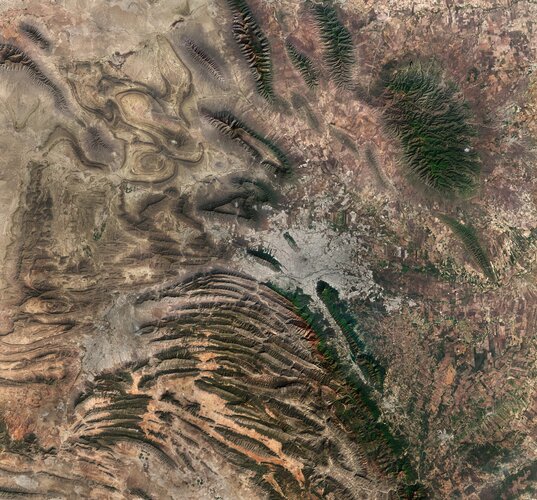This Copernicus Sentinel-2 image features the diverse landscape surrounding Monterrey, the capital of the northeast state of Nuevo León, Mexico.
Zoom in to explore this image at its full 10 m resolution or click on the circles to learn more.
This image, acquired on 5 March 2023, shows a region which combines mountain ranges, agricultural plains, arid areas, as well as densely populated urban centres.
The metropolitan area of Monterrey, visible in shades of grey in the centre of the image, is the second largest in Mexico with around five million inhabitants. It is crossed by the Santa Catarina River, which is usually fed by flowing underground water, although the river was predominantly dry when this image was acquired.
Monterrey is 540 m above sea level and is nestled at the foothills of the Sierra Madre Oriental, the folded mountain range that can be seen in the bottom-left of the image.
The Cumbres de Monterrey National Park lies in the northern part of the Sierra Madre Oriental and includes the famous Cerro de la Silla (or Saddle Mountain), which dominates Monterrey’s skyline. The park is a UNESCO Biosphere Reserve and provides approximately 50% of the water consumed in Monterrey and its metropolitan area.
The grey area visible west of the park is the city of Saltillo, the capital of the Mexican state of Coahuila. Saltillo is one of the most industrialised areas in the country and, thanks to its dry and cool climate, has become a popular holiday destination.
The region south of the park appears mostly arid, with only a few centre-pivot irrigation fields visible in the brown areas in the bottom of the image. On the contrary, numerous agricultural areas stand out in the right of the image, with many square-shaped fields thickening along the course of small rivers and canals.



 Image:
This Copernicus Sentinel-2 image features the diverse landscape surrounding Monterrey, the capital of the northeast state of Nuevo León, Mexico.
Image:
This Copernicus Sentinel-2 image features the diverse landscape surrounding Monterrey, the capital of the northeast state of Nuevo León, Mexico.